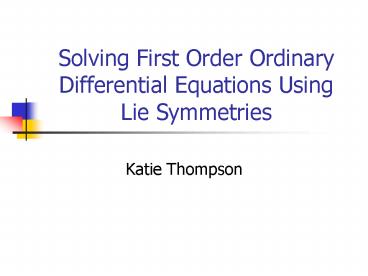Solving First Order Ordinary Differential Equations Using Lie Symmetries - PowerPoint PPT Presentation
1 / 22
Title:
Solving First Order Ordinary Differential Equations Using Lie Symmetries
Description:
Examining 'standard methods' taught in a first course in ordinary ... Then evaluate the integral at r=r(x,y). Solve ODEs Using Canonical Coordinates ... – PowerPoint PPT presentation
Number of Views:823
Avg rating:3.0/5.0
Title: Solving First Order Ordinary Differential Equations Using Lie Symmetries
1
Solving First Order Ordinary Differential
Equations Using Lie Symmetries
- Katie Thompson
2
Overview
- Discrete symmetries vs. continuous symmetries.
- What is a Lie symmetry?
- Using Lie symmetries to solve first order
ordinary differential equations. - Examining standard methods taught in a first
course in ordinary differential equations.
3
Transformations that are Symmetries
- We look at diffeomorphisms on the plane, i.e.,
maps ?R2? R2. - ?(x,y)(f(x,y),g(x,y)), which are invertible and
infinitely differentiable. - The set of diffeomorphisms ? forms a group
under composition.
4
Symmetries of Differential Equations
- A symmetry of a differential equation is a
transformation that sends solutions to solutions. - The identity map is a trivial example of a
symmetry. - Let y(x)?(y). Then a translation in x sends
solutions to solutions.
5
Discrete vs. Continuous Symmetries
y
- A rigid square has a finite, discrete set of
symmetries. - We interest ourselves in infinite sets of
continuous symmetries. - Consider the unit circle x2y21.
?
x
Any rotation by ?? R about the center is a
symmetry. We denote the set of symmetries
??(x,y)(xcos?-ysin?,xsin?xcos?).
6
One-Parameter Lie Group Properties
- The set of diffeomorphisms ?? for
- ?? R forms a one-parameter Lie group if the
following hold - ? 0 is the trivial symmetry.
- ???????.
- Notice that the above imply that ?-???-1.
7
Example of a One-Parameter Lie Group
y
- Again, consider the unit circle x2y21.
?
x
Any rotation by ?? R about the center is a
symmetry. We denote the set of symmetries
??(x,y)(xcos?-ysin?,xsin?xcos?).
8
Symmetry Condition
- For the first-order ODE y(x)?(x,y), a symmetry
group preserves the equation, i.e.
- This is equivalent to the condition
9
Example
Scaling is a symmetry of this ODE.
Verify the symmetry condition
10
Goal
- We want to use the Lie symmetries to separate
variables and find the general solution for a
first-order ordinary differential equation. - From the symmetries, we find canonical
coordinates. The canonical coordinates are the
key to separating variables.
11
Infinitesimal Generators
- Let p(x,y) be a point in R2 and let ?? be a
one-parameter Lie group. - Then the orbit of p under the group action is the
set, Op??(p)?? R. - Then we define the infinitesimal generator of ??
at the point p as the tangent vector to Op at ?0.
12
Canonical Coordinates
- We want to calculate canonical coordinates,
(r,s)(r(x,y),s(x,y)). - These canonical coordinates are built so that the
Lie symmetries become translations (r,s?). - Then the ODE reduces to
13
Canonical Coordinates
- We know that for the translation, (r,s?), the
tangent vector at (r,s) is given by (0,1). - We use the chain rule to get
14
Canonical Coordinates
- We can find r by solving
- Solve r(x,y) for y.
- We find s by calculating
- Then evaluate the integral at rr(x,y).
15
Solve ODEs Using Canonical Coordinates
- To reduce the ODE to separation of variables,
rewrite in terms of canonical coordinates.
16
First-Order ODEs of Homogeneous Type
- These are differential equations of the form
- Make the substitution z(x)y(x)/x.
- Use this substitution to solve the ODE.
- This method comes from the symmetry
17
Canonical Coordinates
- Then canonical coordinates are given by
- We rewrite in terms of canonical coordinates to
get
18
Example of 1st Order ODE of Homogeneous Type
19
Riccati Equation
20
Solutions to Riccati Equations
- Apply the transformation (ye-2?, xe?) to the
solution when c is nonzero.
- When c0, the transformation sends the curve to
itself.
21
Beyond 1st Order ODEs
- Higher Order ODEs Symmetries are used to reduce
the order of the differential equation. - Partial Differential Equations
- Methods to find symmetric solutions are well
understood. - General methods to find non-symmetric families of
solutions are not known, and is an open area of
research.
22
References
- Edwards, C. Henry and Penney, David E.
Differential Equations Computing and Modeling.
Upper Saddle River, NJ Prentice Hall 2000. - Hydon, Peter E. Symmetry Methods for Differential
Equations A Beginners Guide. Cambridge, UK
Cambridge University Press, 2000.































